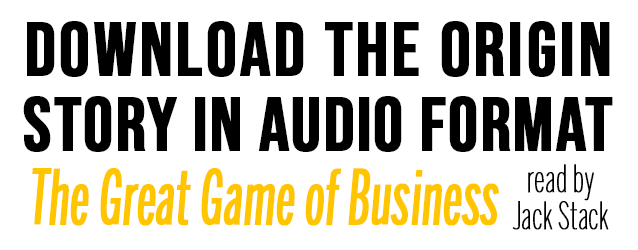
Every October, we conduct our second sales-and-marketing meeting of the year (the first is held in June)—a ritual we’ve continued every year since 1983. The sales teams from each of our divisions make presentations to everyone inside the company—including our board of directors—and we ask our people to vote on their confidence in those plans. For us, this process—what we call High-Involvement Planning—is the lynchpin of how we build a true culture of engagement inside our business.
As you might imagine, given all the uncertainty we’re dealing with these days—from the pandemic and forest fires to trade wars and the election—we got a good dose of bad news mixed with the good when we got together, virtually, to hear these presentations the second week of October. Some of our divisions are doing better than others. All of them shared with us about how they planned to get back on track toward fulfilling their five-year vision. But the real litmus test of those plans was whether our 1,800 associates believed in them or not. And this year, we got a bit of a surprise wake-up call.
Back in June, our associates reported an 80% confidence rate in our sales plans for 2021 and for the next five years. But by October, that confidence rating had dropped to just 74%. Based on the Catholic school system of the 1960’s, a 74 is the same as earning a C. Sure, we’re not failing, and the ongoing pandemic certainly deserves some credit for the drop. But it’s also a clear sign we have some work to do in terms of getting our people more engaged and confident in building their plans for the future.
Understanding how to take action on the confidence scores you get from your associates is actually an overlooked—and essential—component of building a company that can last for a long time into the future. Maybe even for 100 years or more.
Building Real Engagement
We learned long ago, as one of our Higher Laws states: “People support what they help create.” One of the goals of our high-involvement planning process is to eliminate the “us-versus-them” that’s so common in traditional company cultures, as well as the finger-pointing that results when plans don’t work. If you’ve participated in creating the plan, you can’t blame anyone else for why it didn’t work.

Another Higher Law we use a lot is: “It’s easy to stop one person, but it’s pretty hard to stop 100.” Our high-involvement process is designed to be inclusive—and to begin as close to the frontline as possible. Not only does that mean asking people to participate in gathering the competitive data from their industry to create our sales plans, it also means asking them how confident they are in the plan that’s presented to them.
In our company’s case, we ask our sales team to present to their own divisions first before they present to the board and the other divisions. That way, the associates in each division can pose their questions and concerns about the plan before it is shared with everyone else. We then survey the associates and ask them, using a scale of 1-to-10, how confident they are in both the sales plan as well as the what was outlined for growth and contingency plans. We then tally the scores. If we get an average score of 9, we could say people are 90% confident in the plan.
I can’t tell you how powerful this approach is—especially in these crazy times when it’s not always clear what’s a fact versus a lie. It’s hard to sell credibility these days. But those survey results give you an accurate snapshot of whether your employees are engaged—or not. Just like we know that the financials are the scorecard for the health of the business, a confidence score in a sales plan is like getting graded on a test. You might present the most tremendous plan of all time, along with an inspiring vision for future. But if you’re get a low confidence score from your people, that’s an early-warning sign that something’s gone wrong. It’s like getting a 360-degree review on the trajectory of your business from your people. Are they buying it—or not?
Whenever you get a low confidence score on your sales plan, you can probably boil the cause down to a few issues. One, your associates didn’t understand the presentation. That means you didn’t get them involved in creating it or make enough time to explain it to them. Two, the associates simply didn’t buy the plan because they aren’t confident in where the company is going. You can paint the rosiest picture of your company’s future. But if your people don’t buy it, or see themselves helping fulfill that vision, you should see that as a real sign of trouble.
While it’s become common practice for companies to survey employees about how “engaged” they are (we do this as well), isn’t it extremely telling if they tell you they’re not confident in your plan for where the company is heading? Isn’t that perhaps a true level of whether someone is going to be engaged in their work or not?
Acting With Confidence
Consider, as an example, one of our divisions that’s actually performed the best throughout the pandemic—they even paid a partial bonus this year. They also presented what looked like a really strong plan for growth in the coming years. But, strangely enough, their associates reported the worst confidence scores in the history of the company.
It was a surreal experience to sit there and watch the team confidently walk us through the sales-and-marketing template. About forty minutes later, I wanted to stand up and cheer when I saw where they were headed. But then they ended by showing us a slide with their confidence scores: They received a 64% confidence rating in their sales plan and a 65% on their growth plan. You could feel the air sucked out of the room.
When we looked back at their prior presentations, we also observed that the confidence scores had been falling for the past two years—despite their strong results—making it a real red flag for all of us. Why was this team struggling when they had such a strong hand to play?
We now have to ask ourselves questions like: With such a strong plan on paper as well as solid results, why aren’t those associates confident? What’s missing in terms of how we communicated the plan—or how can we get those associates more involved in creating it? When we start digging, what other problems might we find?
Put another way, it’s become an opportunity to fix a deviation—to repair something that was clearly broken. This now becomes our chance to gain a tremendous amount of education and learning throughout the company—a chance to become stronger. Because when we fix something once, we typically fix it for a long time. (We’ll come back and visit what this company does)
There really is nothing more powerful than consensus—when everyone buys into the plan and is excited to execute on it.
Creating an Emotional Response
When the team buys into where you’re going, you unlock the competitive juices that turns work from a boring slog into a game you’re trying to win. Creating that kind of team unity becomes a differentiator in the marketplace. It brings healthy emotions into the workplace—something that I think is often lacking—and that stokes the fires of what we call: You Gotta Wanna. Nothing brings people together better than having a shared goal—and then celebrating once you achieve it.
Look, I recognize that this has been a helluva year for all of us. It’s been tough to read about all the small businesses struggling out there, as well as the people forced to hit the unemployment line, through no fault of their own. It can be tempting to just lay down and wait for something to happen.
But that’s where having an inspiring goal—maybe even a big, hairy, audacious one—ahead of you is so critical to sustaining a healthy culture. By looking ahead, five and even ten years out, you give everyone a chance to have input on what the future could look like and then put the operational plan together of how you’ll get there. That’s how we’ve continued to plan for the future—by giving everyone a sense of hope even when things are so murky in the present—and it stands the test of time.
.png)



.jpg)




.png)




-5.png)


